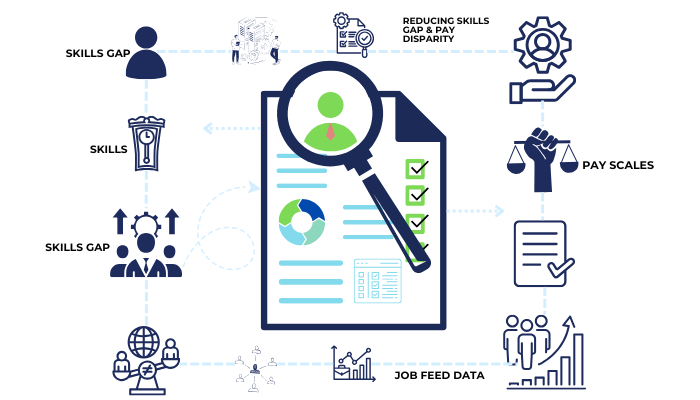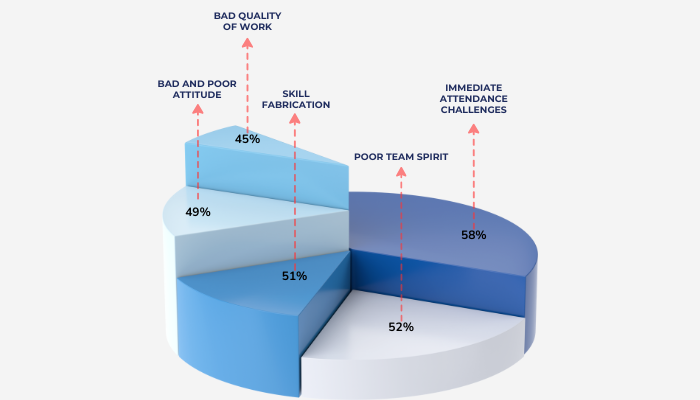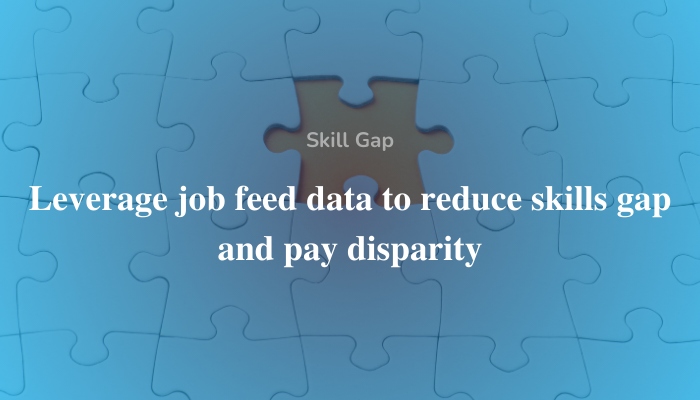How can utilising job feed data serve as the ultimate solution for addressing skill gaps and disparities in pay?
Jobs feed data has revolutionised the labour market. From the basic day-to-day operations to calculating and providing insights into the supply and demand of the market, the jobs data saves recruiters and businesses thousands of work hours and money. However, job listing data does a lot more than providing quality job datasets and scraping the internet for information posted regarding online job ads. Accessing fields like salary, role, and skills- helps policymakers and companies address pay disparity and skill gaps.

U.S. Federal Laws have prohibited employment discrimination since the Equal Pay ACT (EPA, 1963) and Title VII (1964) legislation. In the European Union, ‘Equal Pay for Equal Work’ has been a right of working individuals since 1958. While the outcry against pay disparity has become stronger and louder since 2016, and countries have implemented stronger and fiercer laws to enable pay parity and salary transparency, the ground reality is different.
- Men earn 16% more than women. In a career spanning an average of 40 years, a 20-year-old woman loses USD 407,760 to a man while doing the same job for the same time.
- Women earn 84 cents for 1 dollar of a man.
- Women of colour bear the brunt of it. Hispanic and African-American women make 56 cents for a dollar made by their male counterparts. Native American women get 59 cents against a dollar made by non-Hispanic white men.
The fact that the gender pay gap in the U.S. has stood still for over 20 years is astonishing, which doesn’t incite trust in the workplace economy. Besides the pay disparity, women face an inclusion challenge in certain workforce segments. A survey conducted by The International Information System Security Certification Consortium (ISC2) and Women in Cybersecurity (WICyS) reveals that while cybersecurity as a profession tends to be more inclusive, the pay disparity is evident for ethnicity and gender.
As the acclaimed and talented British actor Olivia Coleman puts it, she would be paid much more if she were Oliver talking about a job with a 12,000% difference in pay! Women are being passed over for promotions, being paid less, are unheard and under-utilised just because of their gender and colour. Smart hiring and training can be the answer to the DEI initiative at the workplace, and job data can achieve this.
Jobs feed data also helps you identify and address the skills gap. While the world is witnessing a wave of nationality, and governments are rushing to put their nation first, companies are struggling to bridge the supply gap and find the right talent to do the job. There are not enough good-paying jobs in manufacturing for the locals to take up. When the Biden Government announced federal subsidies for job creation in manufacturing, companies like Intel and Micron lapped it up. However, despite manufacturing construction being at the second-highest and up by 143 percent since 2019, the jobs are running short due to the skills gap.
The advent of predictive capabilities such as AI and machine learning has also contributed to the widening gap between skills and job placement. Around 375 million workers find themselves facing a job change or an overhaul of their skills to fit the evolving needs of their current jobs while their company may or may not foot the bill for their upskilling. The skills gap is detrimental not only to an employee’s life span but also to the employers.
A Salesforce survey reveals that 60% of IT professionals in the public sector feel inadequate in their AI skills. The skills gap prevents an organisation from reaching its full potential, reducing costs and enhancing efficiency across business processes. Suppose a company keeps letting go of its employees to meet the evolving tech needs or spends money on retraining its existing workforce. In that case, it can lead to piling up of expenses and unproductive work hours that can be avoided.
Workflow disruption is a real, major challenge imposed by the skills gap. 70% of leaders feel that the skills gap is worsening every year. By 2024, the skills set for over 25% of the job requirements will be changed. Even now, content marketing is not what it used to be. Blogging has been replaced by vlogging, and a marketing team’s creative tasks have mostly been moved to AI. ML and blockchain have disrupted BFSI and data analytics, making recruitment challenging. This also puts the focus on educational institutes that might be lagging in providing employable skills to the students.
Many businesses dream of an equitable and all-inclusive workplace without compromising the workplace economy, and job post data can equip businesses to handle the challenges better. Let’s see how.
What is jobs feed data, and how can it lead to solving challenges like pay equity and skills gap?
Job data essentially involves accessing job postings and online job ads across the internet. It is a completely automated process and searches data for pre-defined criteria across specific job listings. Companies, recruitment agencies, and policymakers have used it to enrich jobs data and skills mapping. While jobs data can be custom-made, it usually has information such as salary, skills, and role that recruiters can use to connect with candidates. Jobs feed covers pre-defined multiple attributes such as type of job, geography confines, allocations, meta tags, and filters. It makes searching within the database quicker and more user-friendly.
Thanks to the job data, recruiters don’t have to skim through hundreds of resumes to match the skills and talents of a job posting and can save their productive hours in assessing and evaluating the right talent further.
Jobs feed data is a significant and core component of labour market analysis and workforce recruitment. A mis-hire that doesn’t justify the prerequisites of a job can translate into unnecessary burdens and cost businesses around USD 17,000 every year. However, the cost of a bad hire runs deep, more than causing a dent in the yearly budget. A bad hire can eventually cause irreparable damage to a business. A social media executive with tongue-in-cheek responses everybody loves but doesn’t understand a company’s policy can cause a social uproar in today’s time – Case in point: Dbrand. Besides, there can be a lot of issues with people who lack skills and aren’t equipped to do the jobs they are hired for, Such as:

- 58% of employers reported bad quality of work.
- 52% of employers reported bad and poor attitude.
- 51% of employers reported poor team spirit.
- 49% of employers reported employees lying about their skill set on their resume.
- 45% of employers reported immediate attendance challenges.
Bad hires at a top executive level translate into more damage. If you, as a business owner, want to see how bad hires cost your business more than just the salary, here is the calculator for you.
Jobs feed data integrates relevant data online from job sites such as Indeed, LinkedIn, and Glassdoor and builds a comprehensive, quality job database based on a business requirement. By using jobs feed data to hire employees who match the job requirements and bring the skills required, companies can save money on training and reduce workflow disruption.
For small businesses, jobs feed data can be a real savior. Since SMEs have small, efficient teams, can’t afford to go wrong with their hiring process and often want to save costs on hiring external recruitment agencies, jobs feed data can help them match them with the right talent with the right skill set for the job. Relying on jobs feed data can also bridge the gap between the expectations and challenges of hiring new talent.
For instance, the tech industry is going through a silent recession and warding off hardships among mass layoffs, yet companies are still struggling to find the right hire. While the CEOs and think tanks are hardwired to have an office-first culture, the new generation of data engineers and IT analysts want a work-life balance and a remote work culture. With the pandemic over and companies trying to rebuild their culture, finding the right fit is getting increasingly difficult.
With job listing data, businesses can listen to the younger generation’s demands, foster a more humanitarian approach and find a middle-ground that works for both.
Also Read: Everything You Need to Know About Jobs Feed Data Worldwide
Analysing macroeconomics and microeconomics trends with jobs post data

Since the labour market is a key indicator of how the economy is faring, jobs feed data provides visibility at micro and macroeconomic levels of the labour market. The macroeconomic indicators are unemployment and productivity rates, while the microeconomic gauges are working hours and wages. The macroeconomic level is impacted by domestic and international market dynamics at play, including immigration, age, and education.
For instance, Brexit has a far-reaching impact on the UK’s growth potential. Britain hardly had time to recover from supply chain disruptions owing to the pandemic, and Brexit added to its woes. While the government wanted companies to recruit and train native workers to put British workers first in force, the companies that relied on migrant workers wanted the visa regulations to be relaxed.
The GDP has underperformed by 5 percent due to lower immigration, inflation, reduced trade, and weak business investment in the country. The elasticity of demand for labour supply was seen shrinking for the lower-skilled sector until it wasn’t. However, visa issuance is at par with the pre-pandemic level for high-skilled sectors. However, this cyclic downturn has resulted in the favour of lower-paid wage workers who were used to poor benefits, unpredictable work hours, and no job safety. This tight labour market sprung the power back to unions, ensuring workers get free meals, paid sick leaves, and flexible hours. The microeconomics of the job market is affected by employee retention, attrition, wages, and working hours and happens at the granular level.
A company’s policy to ensure work-life balance and employees’ welfare impact that. Such key factors impacting jobs and the economy are often overlooked, sometimes not tangible, and often can’t be captured by the businesses despite them being the most impacted by it all. Jobs feed data can help businesses quantify such challenges and understand what employees want, where they are lacking, and how they can ensure their timely training and upskilling.
Jobs feed data also gives businesses a peekaboo into their competitors’ expansion strategies. A jobs feed data picking up a competitor’s job opening can bring insights into whether they are hiring for a new role and expanding the current team. If they are hiring over and over for a similar profile, it also reflects the company’s inner workings.
A high attrition rate for a company doesn’t seem so good. Besides, a hiring freeze despite a booming economy indicates possible downsizing, the market’s volatility, or a disturbed internal ecosystem- all that can work in other businesses’ favour. Delving into the jobs feed data also helps businesses in industry forecasting, where they can predict the growth of an economy and, thus, are in a better position to chart their expansion plan or vice-versa.
Identifying skill sets and skills gaps with jobs feed data
Running a jobs API can help you measure such tangible and intangible impacts on the skill set. The advent of AI and predictive technology has transformed the recruitment industry. The pandemic has brought about an ever-lasting impact on the ecosystem. With employees working from home and social distancing, legacy and traditional businesses had a hard time going digital. They either didn’t have the resources, or their employees didn’t have the necessary technical skills. This may seem like a hyperbole for IT and data services companies, but this is a harsh reality for many businesses. 93% of 500 surveyed UK businesses admitted IT skills, and 42% feel that technological advancements are happening quickly for them to catch on.
Similarly, automation and advancement in digital technology have decreased several job profiles, including postal service clerks, data entry clerks, relationship managers and financial analysts. Job listing data not only helps recruiters find top talents but also helps companies stay on top of the evolving job market. By identifying skill sets that are in demand or on their way to becoming obsolete, businesses can use their hiring strategy, invest in re-training and upskilling their staff and maximise the competence of their core teams. Besides this, using jobs feed data can provide insights into the market trends, and companies can use it to stay ahead of the curve. Skills analysing can help them understand the jobs or skill sets that may soon fade into oblivion due to automation or the shift in the jobs market. This helps them attract top talents in the industry, fine-tune their growth strategy and chart their expansion plan in accordance with the volatility of the market. Additionally, partnering with a nearshore team can help businesses address skill gaps efficiently by accessing skilled professionals from nearby regions, ensuring a faster response time and reduced overhead costs. Remote device management can further optimize workforce efficiency by ensuring secure and seamless access to systems for remote teams.
Also Read: How jobs feed data can unlock market trends?
Tackling pay disparity with jobs data
Honestly, there is no other way to say it. Pay disparity is unethical and a corrupt practice. Paying people more for their genders doesn’t really bode well for your business and evokes trust. If your business is your dream and passion and you are in this for the long haul, keep your employees happy, adopt fair business practices and have their salaries transparent. Jobs feed data helps you accomplish salary benchmarking for the various job profiles you are hiring for. Championing pay equity can help build a positive image in the industry that no PR campaign can do for you and attract top-tier talent.
BizProspex jobs feed data for workplace pay parity, salary benchmarking and skills gap analysis

BizProspex Jobs feed data can help businesses monitor labour market and industry recruitment trends and stay on top of skills demands. It helps you:
- Track industry trends and make data-driven decisions
- Identify top candidates and attract relevant talents
- Understand the labour market and use hiring trends to predict the market and economy
- Ensure pay parity and skills-based hiring at the workplace
With BizProspex, your business can embrace a different perspective for hiring and ensure an equitable workplace ecosystem. Happy employees are the not-so-secret recipe for a prosperous and profitable workplace. BizProspex jobs post data helps businesses derive strategic insights and adopt a proactive, comprehensive approach to hiring the right talent and addressing these challenges. While recruitment agencies can source relevant job posts to a unified database, businesses can track evolving demands for skills, do salary benchmarking and hire relevant people.
The team is seasoned, has diverse work experience and understands the job market. The jobs data is automated, agile and custom-made. Equipped with predictive analytics tools, it helps businesses grasp complex international job markets and industry trends. We also help you with data enrichment of jobs feed by offering comprehensive, accurate, verified and secure information on the missing and outdated fields. The best part is that the BizProspex jobs data feed is completely automated and has no maintenance or infrastructure cost. We can get you started in less than 24 hours!
So, what are you waiting for? An equitable and ethical workplace is just a click away! Contact us here to get a demo for a customised job listing data.

